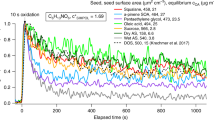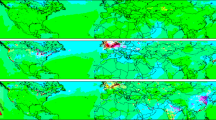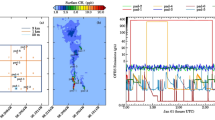Abstract
During the atmospheric transport of combustion-generated emissions of SO2 and NO from point sources, the kinetics of oxidation processes are of particular importance in determining the pattern of subsequent wet and dry deposition because oxidation products such as sulphate aerosol and nitric acid may have deposition characteristics totally different from those of primary emissions. Modelling studies1 have indicated the importance of the ambient air composition and of the dispersion rate on chemistry within plumes during the early stages of transport from point sources, and the important role of mixing in determining oxidant concentrations, particularly ozone, has been demonstrated in near field measurement programmes2–5. It has been generally assumed (see ref. 5) that the significant consequences of dispersion are confined to the early stages of long-range transport and observations to date (see refs 5, 6) indicate that the strong influence of dispersion on plume chemistry is exerted over distances <100 km from source. We report here results of measurements made by an instrumented aircraft of the chemistry within a labelled plume on a trajectory over the North Sea which indicate that oxidation of plume material may be limited by dispersion at distances of at least 650 km.
This is a preview of subscription content, access via your institution
Access options
Subscribe to this journal
Receive 51 print issues and online access
$199.00 per year
only $3.90 per issue
Buy this article
- Purchase on Springer Link
- Instant access to full article PDF
Prices may be subject to local taxes which are calculated during checkout
Similar content being viewed by others
References
Cocks, A. T. & Fletcher, I. S. Atmos. Envir. 16, 667–678 (1982).
Hegg, D., Hobbs, P. V., Radke, L. F. & Harrison, H. Atmos. Envir. 11, 521–526 (1977).
Richards, L. W. et al. Atmos. Envir. 15, 2111–2134 (1981).
Meagher, J. F., Stockburger, L., Bonnano, R. J. & Luria, M. Atmos. Envir. 15, 2263–2272 (1981).
Gillani, N. V., Kohli, S. & Wilson, W. E. Atmos. Envir. 15, 2293–2373 (1981).
Gillani, N. V. & Wilson, W. E. Ann. N.Y. Acad. Sci. 338, 276–296 (1980).
Kallend, A. S. et al. Final Rep. to EPRI Contract RP 1311–1 (1982).
Cocks, A. T., Fletcher, I. S. & Kallend, A. S. in Air Pollution Modelling and its Application II, NATO/CCMS Vol. 3 (ed. de Wispelaere, C.) 137–157 (Plenum, New York, 1983).
Penkett, S. A., Jones, B. M. R., Brice, K. A. & Eggleton, A. E. J. Atmos. Envir. 13, 123–137 (1979).
Chameides, W. L. & Davis, D. D. J. geophys. Res. 87, 4863–4877 (1982).
Author information
Authors and Affiliations
Rights and permissions
About this article
Cite this article
Cocks, A., Kallend, A. & Marsh, A. Dispersion limitations of oxidation in power plant plumes during long-range transport. Nature 305, 122–123 (1983). https://doi.org/10.1038/305122a0
Received:
Accepted:
Issue Date:
DOI: https://doi.org/10.1038/305122a0
This article is cited by
-
Formation of secondary air pollutants and their occurrence in Europe
Experientia (1985)
-
Black acidic snow in the remote Scottish Highlands
Nature (1984)
Comments
By submitting a comment you agree to abide by our Terms and Community Guidelines. If you find something abusive or that does not comply with our terms or guidelines please flag it as inappropriate.



